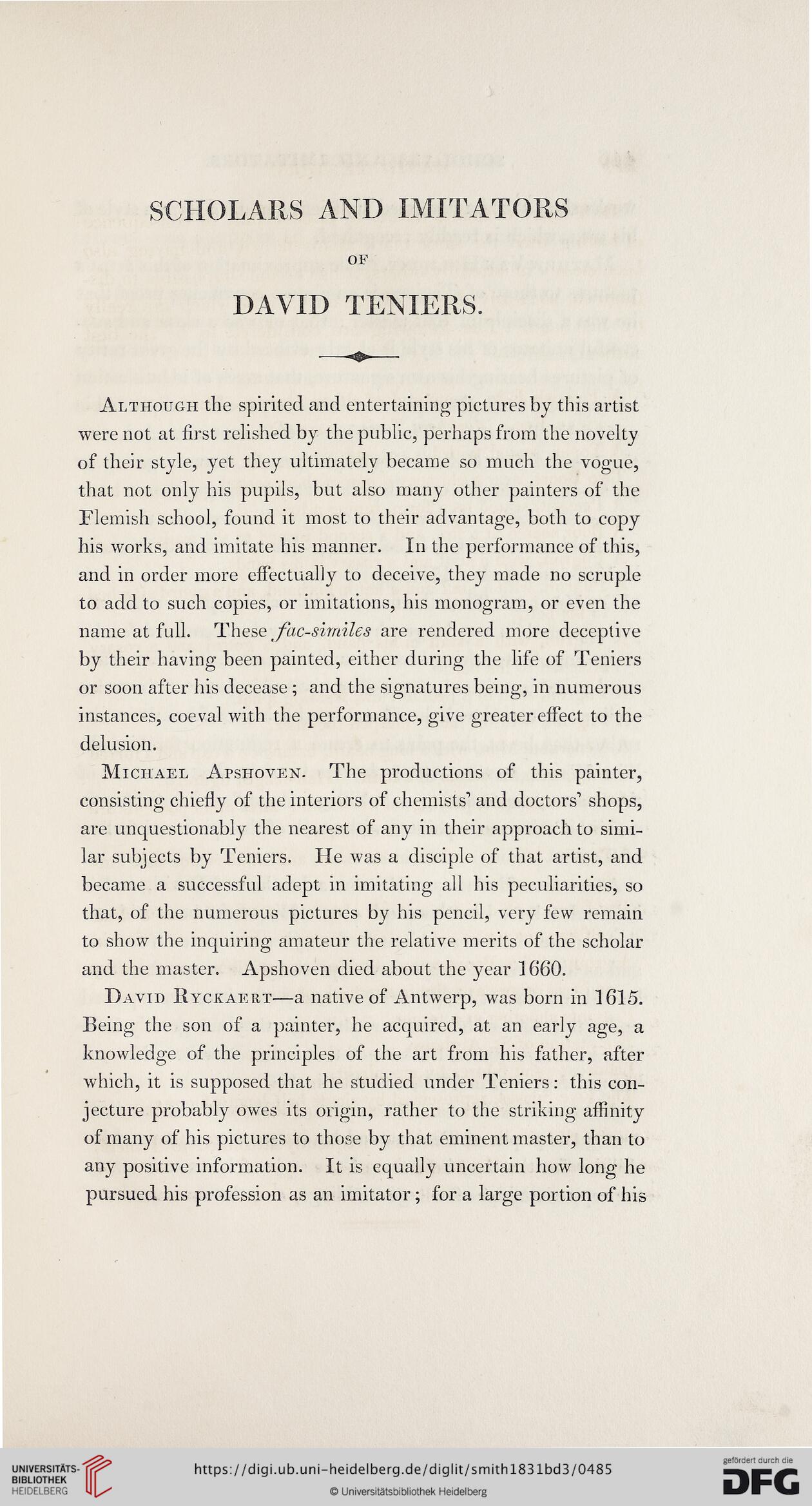SCHOLARS AND IMITATORS
OF
DAVID TENIERS.
•-
Although the spirited and entertaining pictures by this artist
were not at first relished by the public, perhaps from the novelty
of their style, yet they ultimately became so much the vogue,
that not only his pupils, but also many other painters of the
Flemish school, found it most to their advantage, both to copy
his works, and imitate his manner. In the performance of this,
and in order more effectually to deceive, they made no scruple
to add to such copies, or imitations, his monogram, or even the
name at full. These facsimiles are rendered more deceptive
by their having been painted, either during the life of Teniers
or soon after his decease ; and the signatures being, in numerous
instances, coeval with the performance, give greater effect to the
delusion.
Michael Apshoven. The productions of this painter,
consisting chiessy of the interiors of chemists’ and doctors’ shops,
are unquestionably the nearest of any in their approach to simi-
lar subjects by Teniers. He was a disciple of that artist, and
became a successful adept in imitating all his peculiarities, so
that, of the numerous pictures by his pencil, very few remain
to show the inquiring amateur the relative merits of the scholar
and the master. Apshoven died about the year 1660.
David Ryckaert—a native of Antwerp, was born in 1615.
Being the son of a painter, he acquired, at an early age, a
knowledge of the principles of the art from his father, after
which, it is supposed that he studied under Teniers: this con-
jecture probably owes its origin, rather to the striking affinity
of many of his pictures to those by that eminent master, than to
any positive information. It is equally uncertain how long he
pursued his profession as an imitator; for a large portion of his
OF
DAVID TENIERS.
•-
Although the spirited and entertaining pictures by this artist
were not at first relished by the public, perhaps from the novelty
of their style, yet they ultimately became so much the vogue,
that not only his pupils, but also many other painters of the
Flemish school, found it most to their advantage, both to copy
his works, and imitate his manner. In the performance of this,
and in order more effectually to deceive, they made no scruple
to add to such copies, or imitations, his monogram, or even the
name at full. These facsimiles are rendered more deceptive
by their having been painted, either during the life of Teniers
or soon after his decease ; and the signatures being, in numerous
instances, coeval with the performance, give greater effect to the
delusion.
Michael Apshoven. The productions of this painter,
consisting chiessy of the interiors of chemists’ and doctors’ shops,
are unquestionably the nearest of any in their approach to simi-
lar subjects by Teniers. He was a disciple of that artist, and
became a successful adept in imitating all his peculiarities, so
that, of the numerous pictures by his pencil, very few remain
to show the inquiring amateur the relative merits of the scholar
and the master. Apshoven died about the year 1660.
David Ryckaert—a native of Antwerp, was born in 1615.
Being the son of a painter, he acquired, at an early age, a
knowledge of the principles of the art from his father, after
which, it is supposed that he studied under Teniers: this con-
jecture probably owes its origin, rather to the striking affinity
of many of his pictures to those by that eminent master, than to
any positive information. It is equally uncertain how long he
pursued his profession as an imitator; for a large portion of his




